Writing is an art and discovering the secrets of boosting your readers’ engagement can transform you into a master of copywriting. Setting the right tone, answering to questions, drawing attention, adding personality and bringing your content alive with visuals or interactive data are just a few techniques that can get you where you want.
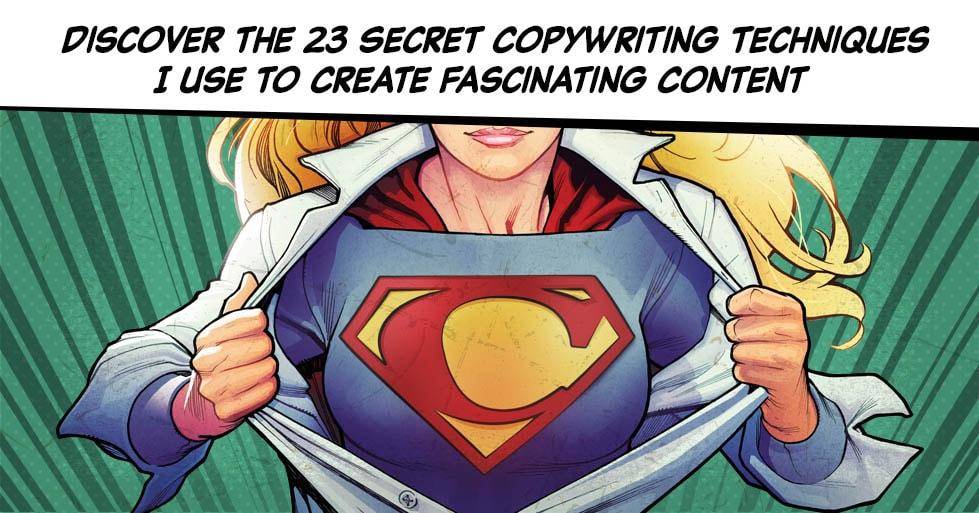
You know that warm feeling you get when you speak with one of your friends? You talk, he listens, he asks questions and so on. You understand each other. A similar feeling can be established with your readers as well. How, you may ask? It’s not a bulletproof formula but for sure it will be extremely helpful to follow the next 23 rarely used copywriting techniques to help you boost your engagement.
- Use the Serial Position Effect
- Make Your Visitors Feel Important by Offering Exclusive Content
- Use the “Bizarreness Effect” to Draw Attention
- Use “Powerful” Keywords like “New”, “Free”, “Now”
- Use Copywriting Formulas to Create Captivating Content
- Be a Unicorn in a Field of Horses
- Take Advantage of the FOMO Technique
- Include Emotions, Promise, and Main Keyword to Make Your Headlines Viral
- Create a Persona Based Content Strategy
- Be the First to Jump on Trends
- Ask Your Target Audience to Contribute
- Pack More Personality into Your Content
- Perfect Your Writing Tone to Your Readers
- Craft Good Stories That Sell
- Give Your Content a Quick Credibility Boost
- Leverage Emotional Triggers in Your Content Marketing
- Build Social Media Friendly Content
- Use Statistical Data to Enhance Your Content Marketing
- Transform Your Q&A into an Article to Help Your Audience
- Use Social Proof to Back up Your Content
- Make Your Content More Visually Interactive
- Define the Purpose Behind Everything You Write
- Make Your Content Familiar to Resonate with Your Audience
1. Use the Serial Position Effect
The serial position effect refers to the situation when a person recalls the words from the beginning and the end of a list rather than the ones from the middle. According to a study made by Indiana University, the participants were able to remember the first and last words from a list of 20.
Following this technique, you should write the key points of your sales pitch or any other important information at the beginning and end of your blog post.
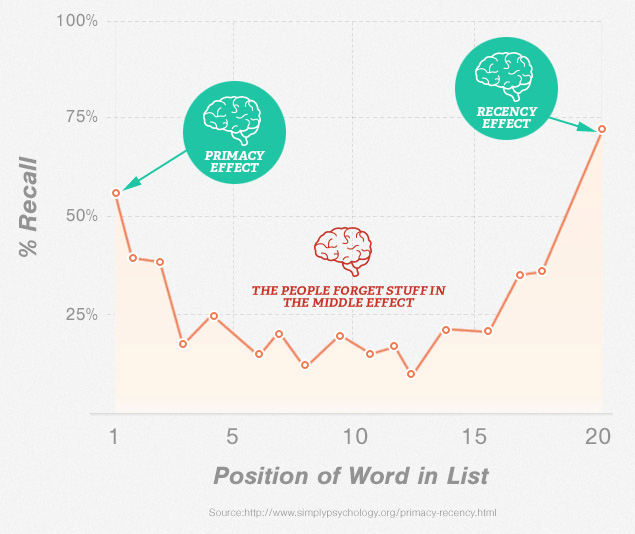
Source: https://copyhackers.com/wp-content/uploads/2013/07/serial-position-effect.png
2. Make Your Visitors Feel Important by Offering Exclusive Content
Another technique you can use to boost your engagement is to offer content your readers couldn’t find elsewhere. Make them feel important; they will start to appreciate you more. Don’t you love it when someone is sharing with you a piece of information that has never been said to anyone else?
Exclusive content comes in different forms: a webinar with a script for those who sign up, training opportunities, e-books for subscribers, news from conferences and events in the industry turned into blog posts.
3. Use the “Bizarreness Effect” to Draw Attention
Using ridiculous material to be better remembered instead of common material translates into the bizarreness effect. This technique is borrowed from Psychology. Studies have shown that people were able to recall nouns presented in bizarre sentences such as “The dog rode the bicycle down the street” rather the nouns from the common counterpart “The dog chased the bicycle down the street”. On the other hand, some specialists say the bizarreness isn’t the thing that enhances the memory, but rather the distinctiveness of the meaning.
You can use the bizarreness effect to be spontaneous and say something indubitably wild.
4. Use “Powerful” Keywords like “New”, “Free”, “Now”
Another valuable copywriting technique is taking advantage of powerful keywords in your content. Persuading words can have a stronger impact compared to other types. When talking face to face, it is easier to make a point due to the use of intonations and body language. In writing, it is a bit harder. The best call will be to use strong keywords to point out key notes in your content.
You can take advantage of powerful words in order to convey emotions. For example, you could use:
- ridiculous instead of stupid;
- entertaining instead of funny;
- delightful instead of nice;
- magnificent instead of beautiful.
Beside using vivid adjectives, you might try having verbs that are more expressive. It is recommended to use first person pronouns such as “I” and “you” to give the impression of having a dialogue with your reader. Also, try to use causal prepositions such as “because” or “due” to give arguments and demonstrate your affirmations. It was proved in a study where people have shown more will to heed to a request after the word “because” was used.
Words like “new”, “now” and “free” can also have a strong impact on the audience if they are used at the right moment.
5. Use Copywriting Formulas to Create Captivating Content
Whether we want to tell a captivating story, write a killer content or have inspiring headlines, you can use these formulas to boost the engagement. Until now, I’ve mentioned the 4 U’s Formula: Urgent, Unique, Useful, and Ultra-specific. A similar formula is the 4 C’s: Clear, Concise, Compelling, Credible.
If you want to offer benefits through a blog post, you could use the Before – After – Bridge formula. “Before” is the situation where you imagine a problem that doesn’t exist. “After” is the situation where you resolve the problem. The “bridge” is the way to get there.
A formula that has been used for a long time is AIDA, where you have to grab the reader’s attention, offer interesting information, develop desire and create the action.
You could also try the Picture – Promise – Prove – Push (PPPP) formula. Using it, you can paint a picture to grab the reader’s attention, then make a promise, provide support for your promise and determine your reader to take action.
A good way to catch the reader on the “hook” is by using the Open Loop tactic. It is used more often in books to create suspense through a cliffhanger. At that moment you hold back information to grab your reader’s attention and make him read the whole post.
The “3 reasons why” is another formula to help you write engaging content. You have to answer three questions, as the name says it:
- Why are you the best?
- Why should I believe you?
- Why should I buy right now?
On the web, you’ll find lots of other formulas that can help you discover what works best for you.
6. Be a Unicorn in a Field of Horses
Be smart and seek guidance from tools such as BrandMentions to spy on your competitors who write about topics you’re interested in. Search and read what they’ve written to find ways to have vivid content, and different approaches to the topic to “steal” their audience. If you have something new to write about, make a research to see if your competitors wrote something similar and how they handled the topic.
After you’ve done your homework, tie it all together with a value proposition. A well-known quote says “Be a unicorn in a field of horses”. For that you can apply the 4 U’s formula: be urgent, unique, useful, and ultra-specific.
If you follow some of the lesser-known copywriting techniques we’ve talked about so far you can create your own formula to differentiate yourself from the competition.
7. Take Advantage of the FOMO Technique
FOMO is the acronym for fear of missing out, and some of you may know this feeling. Taking advantage of this technique involves using information such as limited offers, discounts, and other exclusive events, to lead your readers towards an action.
An example of a limited offer from Starbucks can be seen in the next photo:

This technique works very well for millennials. From a study made by Eventbrite of 2,100 adults (507 of whom were millennials aged 18 to 34) it resulted that 69% of millennials fear missing out social events.
Due to FOMO, it is a blooming era for live events. It works very well for “selling” experiences through blog posts out of a product such as meeting your favorite influencers at a conference, having a personalized balloon ride in your holiday, exceeding your dreams by doing the sport you like, listening live your favorite singers at a festival and so on.
8. Include Emotions, Promise, and Main Keyword to Make Your Headlines Viral
Headlines have a significant impact on whether your content gets opened or not. You have a headline for a blog post, for a SlideShare presentation, for a video, for an infographic, for a news article, for an ad, for a webinar, for a guide, for an e-book, for almost everything you write online.
Around 80% of readers never make it past the headline, leaving almost 20% of them who will read. But before that you need to past the test of showing awesome in the search engines. And these statistics say a lot about how important the headlines are. You should have clickbait headlines to increase the open rate.
We live in the fastest phase of human history, and we can’t afford to make the reader lose interest in our site/blog after reading the headlines. We must create desire and interest from the beginning. Say no to low CTR!
Below you can see an example of a compelling headline for a webinar. Isn’t it true that it makes you sign-up?

It gives you the guarantee you’ll find out hints to recover your site if it got hit by the Penguin penalty.
While searching online, you’ll find lots of useful resources that can offer you guidance on how to create top headlines. Learn how to write killer headlines and to increase your readers’ engagement by following Jeff Goins’ formula. There are five elements. If you combined them, you would be able to trigger the desired actions.
- Number – 3, 10 are best used in the headlines. Using a number in the headline is highly convertible. 36% of headlines use now a number.
- Adjective – use unique adjectives to create a powerful emotion. For example: brilliant, atrocious, stunning, smart, bizarre, dazzling.
- Rational – the way you offer added value such as reasons, tips, secrets, hacks, tricks. Please, don’t ever use things.
- Keyword – a short phrase that tells us what the content is about.
- Promise – what’s in it for me? For example, our headline promises “copywriting techniques that will boost your engagement”.
This is the formula designed for success: Number + Adjective + Rational + Keywords + Promise
Using Jeff Goins’ formula, you can transform lifeless headlines into sparkly ones. For example, “Best Travel Destinations in Europe” can turn into “5 Brilliant Travel Destinations in Europe That Will Spark Your Wanderlust” having “travel destinations in Europe” as a keyword.
Below you can see an example of an inspiring headline for a webinar following the formula written above:
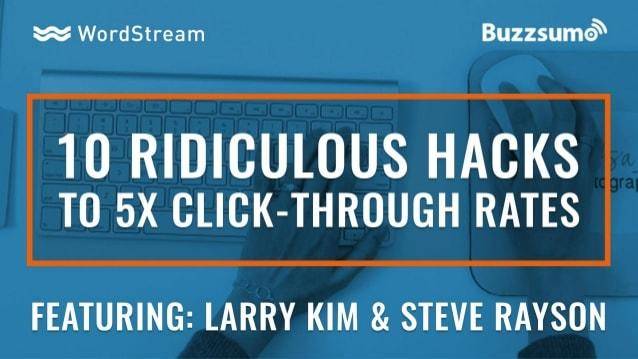
Source: http://image.slidesharecdn.com/buzzsumo-webinar-march-20161-160323161442/95/10-ridiculous-hacks-to-5x-clickthrough-rates-1-638.jpg?cb=1458838636
Also, you can try using BrandMentions to help you to find inspiration for your headlines by looking at your competitors.
It’s important that your content covers all the elements you wrote in the headline.
9.Create a Persona-Based Content Strategy
It is mandatory to know your audience before you even start writing. Start studying what your reader likes, dislikes, what his habits are, what type of content he consumes, in what part of the day he prefers to read, where he comes from, where he is from and other similar demographic and interest characteristics.
After you’ve collected data about your audience, use it to create your content marketing persona. Track your analytics and set metrics to help you deploy trends.
10. Be the First to Jump on Trends
Every copywriter should follow trends in his industry to bring fresh content. A smart way to engage your audience and attract new readers to your site is having worthy content. You can do that by keeping up the news to bring valuable information to your visitors.
A good way to start would be to subscribe to news sites, specialists in the field, watch Google Trends, read publications in your industry, create a Twitter list of influencers you know they deliver hot news as they happen, follow trending hashtags about your main interest. These are just a few ways to keep your eyes open to trending stories. After you’ve gathered all the information, you need to start writing about a trending topic to make your blog post newsworthy.
11. Ask Your Target Audience to Contribute
Smart copywriters know that asking their readers to contribute is an influential copy writing technique. People are anxious to see their work promoted by a brand.
One of the most used ways to ask your audience to contribute is to share photos on social media. Sending emails to contacts to answer a survey, asking questions on blogs or using real reviews to write a blog post are other ways to contribute. Be bold, and try other unique ways to do that.
Kenneth Cole came with an excellent way to make people contribute. The company organized a selfie contest. The brand offered fans the possibility to take a selfie and enter a contest to win free shoes every month for a year.
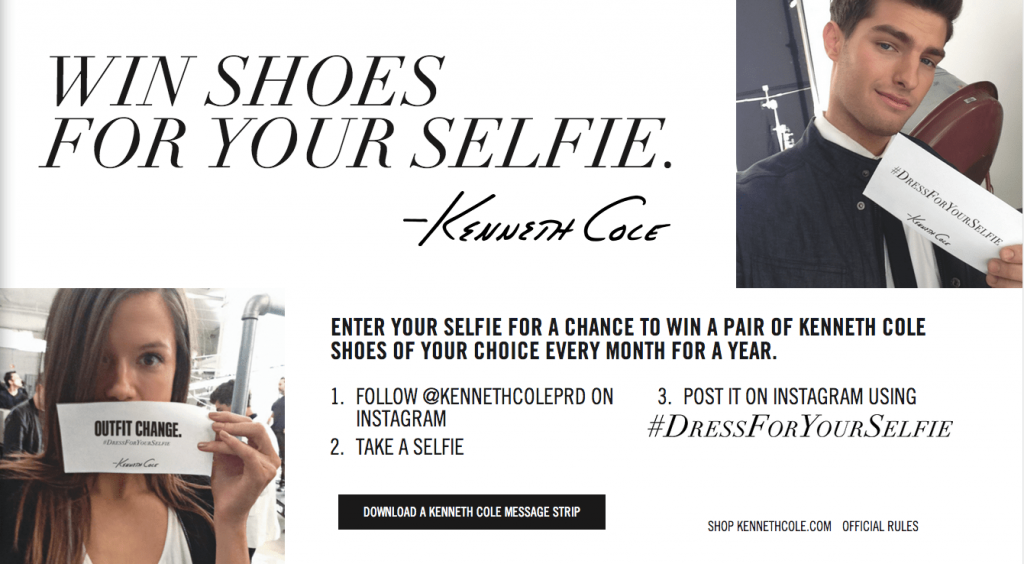
If you know you visitors take selfies, you should try something similar. Selfies are widespread, and it’s simple to engage with the audience. They are personal and can easily lead to an action. The owner will receive likes, comments, and new followers. You can write an article about the pictures you receive and start a story.
Another example is the Christmas Story by the travel agency Rolandia Travel. Last December, the company wanted to offer its readers a soft presentation of how the Holidays are celebrated in Romania.

Travelers could send a short story about how they spent their Christmas in Romania along with a few pictures as a gift of sharing for those who were far from home, but not only. The best stories were published on the blog every week.
12. Pack More Personality into Your Content
Personality is that something that makes you unique. Personality is that something that can differentiate you from the mass, is that something that defines your personal style. Just like a person has it, a brand should have it also. Brands have been developing through the time; they began to have anthropogenic qualities and be more humanized. The personality of a brand can be translated into a unique selling point, a motto or other forms of expression in order for people to know that is about the brand and nothing else.
For example, the personality of Coca-Cola might be connected with happiness, fun, friends, family, being together due to the images and messages communicated consistently in numerous Coke campaigns. Below, you can see how a Coca-cola ad looked like in the 1940:
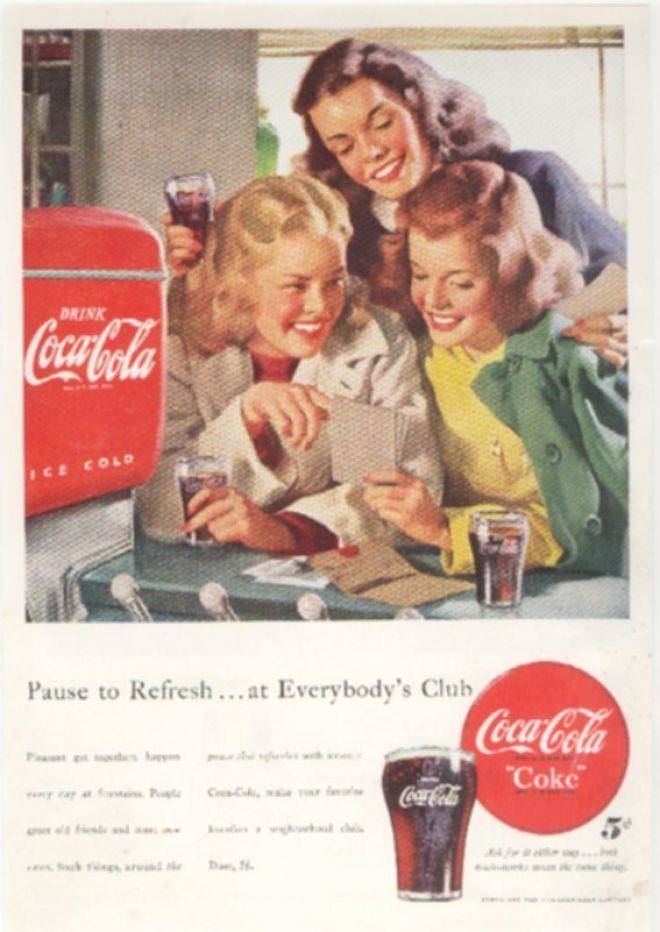
Source: http://www.vintageadbrowser.com/coke-ads
Now, in the 20s this is how an ad from Coca-Cola looks like:

Source: http://www.realites.com.tn/wp-content/uploads/2016/01/coca-cola.jpg
You can see that the message and the way of showing smiling people remain. Both images express happiness, friends, fun.
For a content, personality can be expressed through a unique voice, a style, maybe a personalized closing or a type of personalized covers for articles and so on. Besides that, the content should always reveal the personality of the brand.
13. Perfect Your Writing Tone to Your Readers
For a copywriter having the right copy tone is like having the perfect light for a photographer to shoot the subject. For a painter it can be the right muse.
Your writing tone can either create interest or kill it. The wrong tone can wreck a good piece of information.
When you talk with someone and use a certain tone, you can determine how your interlocutor will respond. A similar situation can be when you use a specific tone in your writings. If the piece of information is entertaining, then the reader will feel cheerful, if it expresses anger he will get angry, if it’s painful he will feel the pain, if it’s boring he won’t have the patience to read it entirely and will leave your site.
There are multiple ways to express your opinions. Take a look at this questions, for example:
- Would you mind if I borrowed your pen, please?
- Can I have your pen?
- Pass me that pen.
Make a difference between formal and informal writing. If you started writing in a casual mood, then stick to it. Don’t make sudden changes, inject unexpected signs of cuteness to become casual or start using a technical language to become more formal than usual. If you have multiple collaborators that write on your blog, make sure they follow the same language. Avoid being inconsistent.
Here are a few marketing tips to help you shape your tone:
- don’t be too casual or too stiff;
- don’t use dialectic or slang language;
- don’t use offensive language (swear or use racism);
- be clear by ordering your words properly in a sentence;
- use singular pronouns (me, you);
- have a personal way of expressing your opinions and wisdom within a topic.
Now, ask yourself: “Do I sound like my visitors expect me to?”
14. Craft Good Stories That Sell
There is no doubt that a good story can captivate us really bad. Let’s be honest. Hasn’t it happened to you to stay up at night reading a good story to find out how it ends? If you succeed sketching a story in the right manner you could transport the reader down the funnel in order to determine him to take an action.
A good story has the gift to help the reader get into a state of well-being.
But how could you do that, you might be asking? I’ve picked up a few tips to help you with that:
- paint a picture: use imagery and lots of details to be more expressive.
- appeal beyond those 5 senses: remember that there are different types of people. Some of them are more visual, others more auditory or olfactory and so on. Make sure to take advantage of sensory words.
- suspense: you can capture their attention by adding a tint of tension and get them to finish the whole article. Try giving your audience something exciting to read.
- killer opening paragraph: a good story can be used as an opening paragraph to allure the audience into getting to the main part of your topic.
- have a model: To make your arguments stronger, you can use a model to show the changes it suffered. You can take examples from your experience or the ones you’ve heard of. Your audience can relate with the people who went through a similar situation.
15. Give Your Content a Quick Credibility Boost
It is ok to write your opinion and give advice, but are you credible? Are people trusting you?
Credibility can be a point sale. People can decide to buy your product depending on whether they trust you or not. Your affirmations should be based on data.
You can build trust if you follow a few guidelines:
- cite sources: well-known field specialists usually offer credibility due to their background. Search for credible sources and specialists to back up your claim.
- take advantage of your years in business and your experience.
- name innovations and awards: if the context asks for such kind of references, use them. These are evidence of your success.
- offer independent survey results: if you’ve run a small research, use the data to back up your arguments.
- have media coverage: a great impact on your readers’ credibility would be to have presence in the news and business publications. If your brand is newsworthy, then you will also get authority in the field.
16. Leverage Emotional Triggers in Your Content Marketing
On the web, you can find lots of bloggers that offer great advice, write captivating content and give informative tips, but don’t know how to connect with their viewers on an emotional level.
The content can have emotional or rational triggers if we follow the classification regarding consumer behavior from psychology. Leveraging emotional triggers is a technique used in psychology to persuade. It can also be used as a copywriting tip, for the same purpose.
In order to stimulate emotions, you have to write content that helps the reader and make him experience a sensation while reading. You can be informative, but try not to exaggerate using a cold voice. If you do so you risk losing your readers because they won’t recall a thing and might never return to your site. We must remember that we write for people, to create a connection with them and to be on the same wavelength. This means you could talk from your experience in a friendly manner, share personal examples, be authentic, ask your audience questions and try to answer to them, share experiences together.
“Emotions are complex and move in various directions. Modeling emotional feelings and considering their behavioral implications are useful in preventing emotions from having a negative effect on the workplace.” – Boundless
Psychologist Robert Plutchik created a wheel of emotions. The most comprehensive way to illustrate the emotions experienced by a human being.
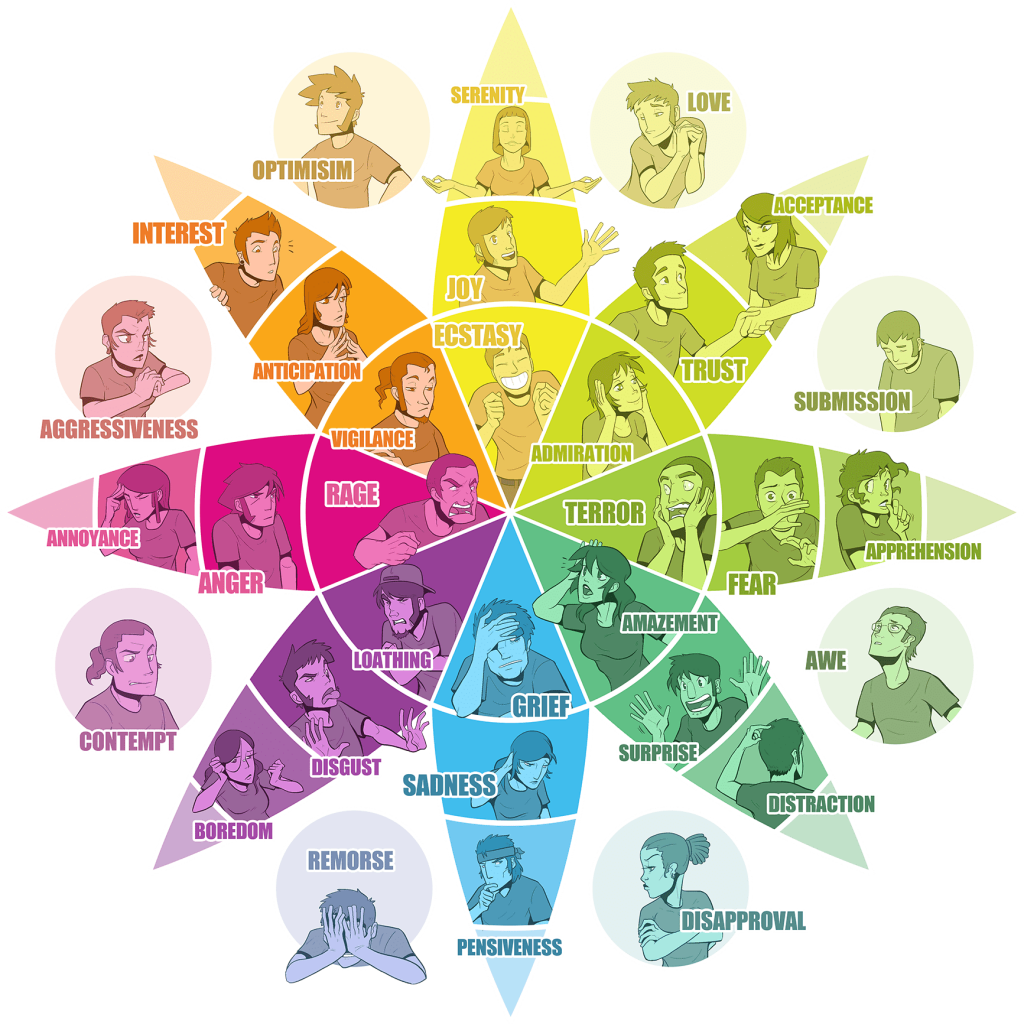
Source: http://www.efoza.com/postpic/2014/03/plutchik-s-emotion-wheel_309528.png
Studies have shown that the positive emotions toward a brand have a higher influence on the loyalty of the consumer rather than its trust. Also, they can help you to communicate more effectively.
Negative, as well as positive emotions, have an influence on a person. When someone experiences something like that they want to do something to avoid the bad feelings. If you talk to your readers and provoke them negative emotions, they will follow you more carefully to reduce their discomfort.
When people are involved with the message, they listen attentively and process using the central route. Emotional appeals create involvement.
One of the most important characteristics of the emotional triggers used as a copywriting technique is they can lead to actions.
Before you take a step forward, it is crucial you know your business and your audience very well. Although connecting with your readers on an emotional level is important, make sure you resonate with them. Be careful to make your audience feel the emotions you wanted it to experience.
17. Build Social Media Friendly Content
After you wrote your post, you should promote it. To make your life easier and not work twice as much, try and make your visual data expressive and relevant to your content. Always make a cover for your content to boost your reach. It is proven that tweets with images receive 18% more clicks and 150% more retweets.
The cover can be used as social media content. Also, I recommend you to make a short description about your topic that you can write as an intro or meta description, as well as a tweet on Twitter or as a post on Facebook and so on.
If you follow these simple guidelines, your readers could easily share your content, too. The visibility of your content will be improved, and other Social Media metrics could experience growth.
18. Use Statistical Data to Enhance Your Content Marketing
Cartograms, scatter plots, time series, diagrams, charts, histograms, matrix, dendrogram, area maps are just some ways of portraying statistical data in your content to make it more animated. To have traffic-driving content type you can create visual content out of statistics.
You can try and create interactive charts or use gifs to maintain your audience focused on your content and increase the user experience. This is just an example:

Source: https://d13yacurqjgara.cloudfront.net/users/57127/screenshots/1917495/attachments/329078/productpage2-2.gif
You can use Visme for animated charts and Canva or Piktochart for static charts. Below, you can see how a chart in Piktochart looks like.
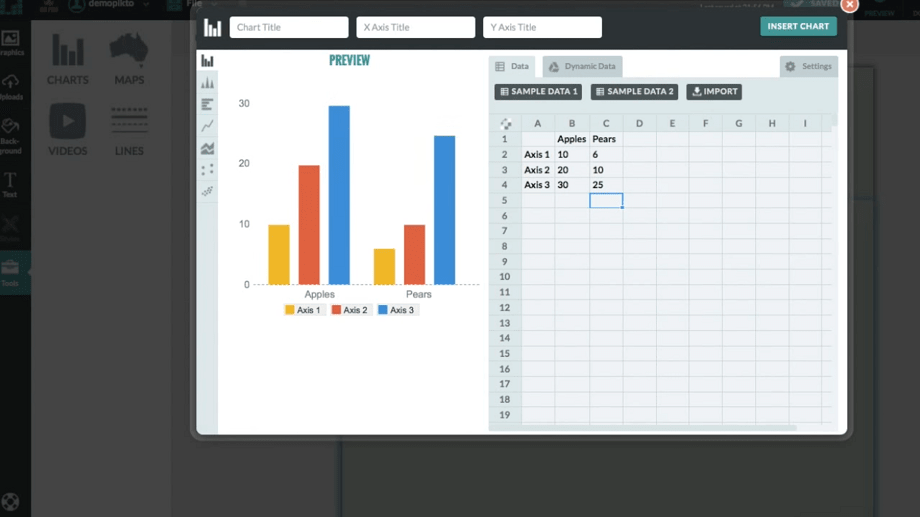
If you use charts, it is easier to understand and to visualize the information, rather than reading chunks of text and numbers.
19. Transform Your Q&A into an Article to Help Your Audience
You can find value in your Q&A. More than that, you could find value in the questions you receive from your readers. First, you should make a list with all the questions you have, then categorize them. Make them sound actionable and sell the idea behind. After you’ve done the final list, you can start writing your blog post, give examples.
Another great source of this kind is Quora. You can search for the best answers in your industry in Quora and transform them into a new blog post. There is a good chance you will get some helpful information and good feedback from your readers.
20. Use Social Proof to Back up Your Content
“Social proof” is a phenomenon where people think that how others are acting in a given situation is the right way to respond in a similar event.
Imagine you want to go to a restaurant and have dinner. You have the possibility to choose from a crowded restaurant with a waiting list and an empty restaurant. You probably think the second one has crappy food. The waiting list is proof that the first restaurant has good food, right? You’d chose the crowded one, wouldn’t you?
Psychologists name this behavior “social proof”. If there is a crowd, that means it is good. The more the people, the more it means something better must happen there, you’d think. Following the crowd is in our nature. It is a simpler decision.
You can attract your audience with the “social proof” technique if you make a blog post out of reviews for your product, have endorsement for your brand, use testimonials in an e-book, write a best practice post from your clients’ experience, write case studies from the data you extrapolated about your customers.
21. Make Your Content More Visually Interactive
Visual content includes infographics, videos, gifs, pictures, presentations. Images are a great asset because they are stored in our long-term memory. It’s not a secret that infographics are highly shareable.
70% of all your sensory receptors are in your eyes. Sources say it takes us less than 1/10 of a second to understand a visual scene.
The article’s cover comes first on the content. You should be very careful how it looks since it’s the first image the reader sees. Having puppies wearing boots might be captivating, but they are not always relevant.

Source: https://s-media-cache-ak0.pinimg.com/736x/9a/57/db/9a57dbd3367259a2db12a34a71cbcd0c.jpg
Along with a strong headline, the cover is a core element for boosting engagement, so make sure you chose wisely.
Get creative and combine the visuals to be interactive, to surprise the visitor and engage him and make him stay more on your site. For example, you could create an interactive how-to guide, or you can simply display unique information. Check the next screenshot to see an example:
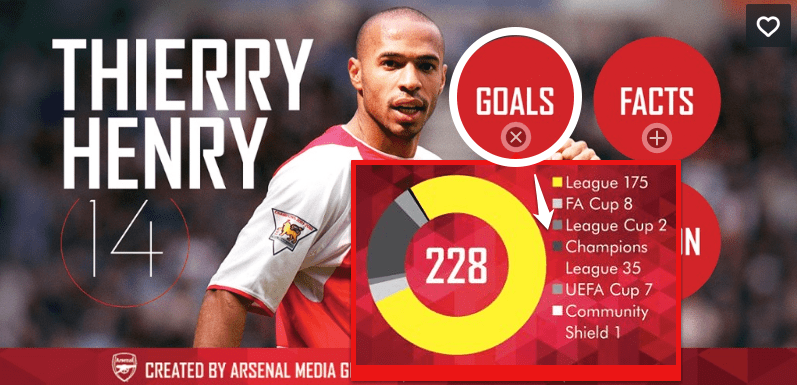
Source: http://blog.thinglink.com/marketing/interactive-infographic-arsenal
If you hover over the plus sign (+) you can see a pop-up box with additional information.
Biz Brain created an interesting way of displaying information about “where does coffee came from”. It shows a journey from bean to cup through a fun and attractive infographic.

It gives the right amount of information without overwhelming the reader. You can scroll down the page to see the whole process.
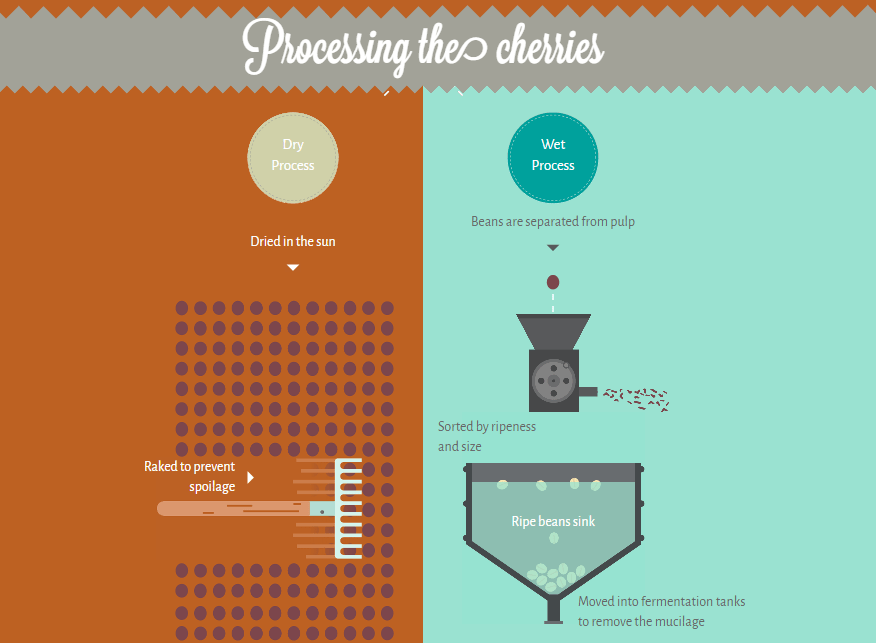
It is one of the most detailed infographics I’ve seen. More than that, it offers an experience. The fact that is interactive gives you the feeling you take part in the whole process. In the end, you “receive” a cup of coffee. You engage in the act of planting the seed, harvesting, processing the beans, milling, exporting, inspecting, roasting, grinding and brewing.
It is an excellent way to captivate the reader and share useful information in a way he can remember. You can work with an agency or a freelancer if you want something more complicated or search for tools to help you create the desired visual impact.
More tips to create interactive content:
- make an interactive calendar to follow past and future events;
- have a virtual assistant for an online product or service right on your site;
- create an infographic from a how-to video;
- turn presentations into gifs;
- compile interviews into an e-book;
- upload customer’s videos about your product on your website;
22. Define the Purpose Behind Everything You Write
While the content is blooming and lots of marketers start to write for the sake of having news content on site, the internet becomes crowded. Don’t get me wrong, it is fine to have a big library of content as long as the information is useful, it has a purpose and answers pertinent questions. Don’t get lost in the pile of dull blogs and boring content.
Make a list of topics, research and see which one will bring more traffic, correlate with the trends and what your audience wants. After you’ve done the analysis you can make a plan/structure for your topic to cover it all. Then implement it. Start writing and always remember what you’ve promised in the headline. Your purpose is to bring arguments and examples, show case studies or other types of information that will confirm your affirmations.
23. Make Your Content Familiar to Resonate with Your Audience
Your content should provide value to the readers. What better way than make it personal? But what does personal mean?
Personal content can be written from your own experience. You can collect data and present it through case studies on the blog, convert your presentations into new articles. Below, you have an example of a SlideShare presentation turned into a blog post.
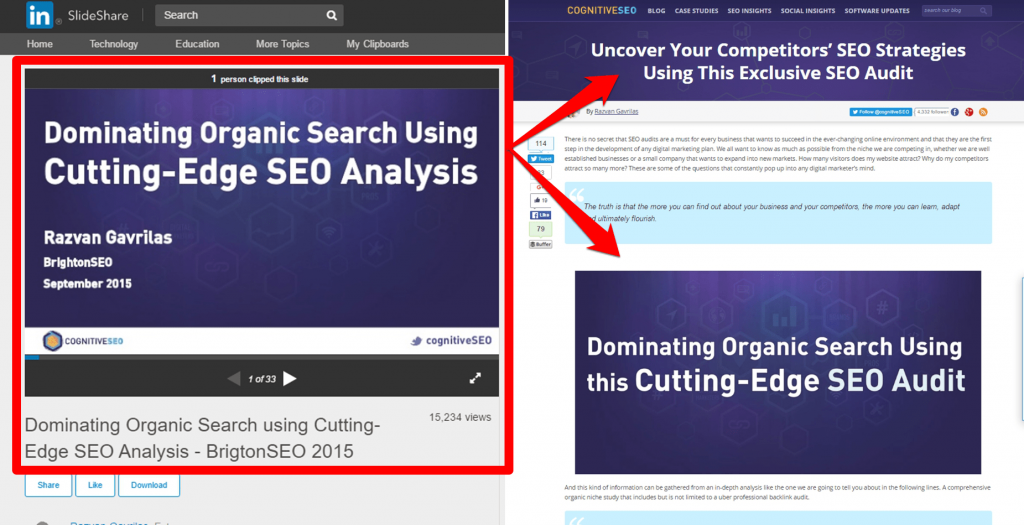
Another way to have personal content is by sharing information from a conference you’ve been to or follow up from a webinar you’ve organized. Beside that, you should use informal writing such as “don’t” instead of “do not” or use the first person pronoun: “We have the possibility to look at our analyzed site and make a conclusion”.
Conclusion
Writing has never been an easy job. Especially now when the internet is constantly changing and the readers are harder to attract on the site.
Think about the fact that you need to be convincing and express more in words to draw attention. People can be easily distracted if you don’t captivate them and keep them engaged. If you are using words that have more sway than others, you might have a positive change in their engagement. Following the “seductive” techniques we’ve talked until now, you’ll have a good change to get the results you’re expecting. Make sure they follow your brand guidelines.
Design your plan and try to implement it correctly. After that, always follow the results and your metrics to increase conversion rates.
The post Copy: 23 Rarely Used Copywriting Techniques to Create Fascinating Content appeared first on SEO Blog | cognitiveSEO Blog on SEO Tactics & Strategies.
Copy: 23 Rarely Used Copywriting Techniques to Create Fascinating Content posted first on http://nickpontemarketing.tumblr.com/
No comments:
Post a Comment